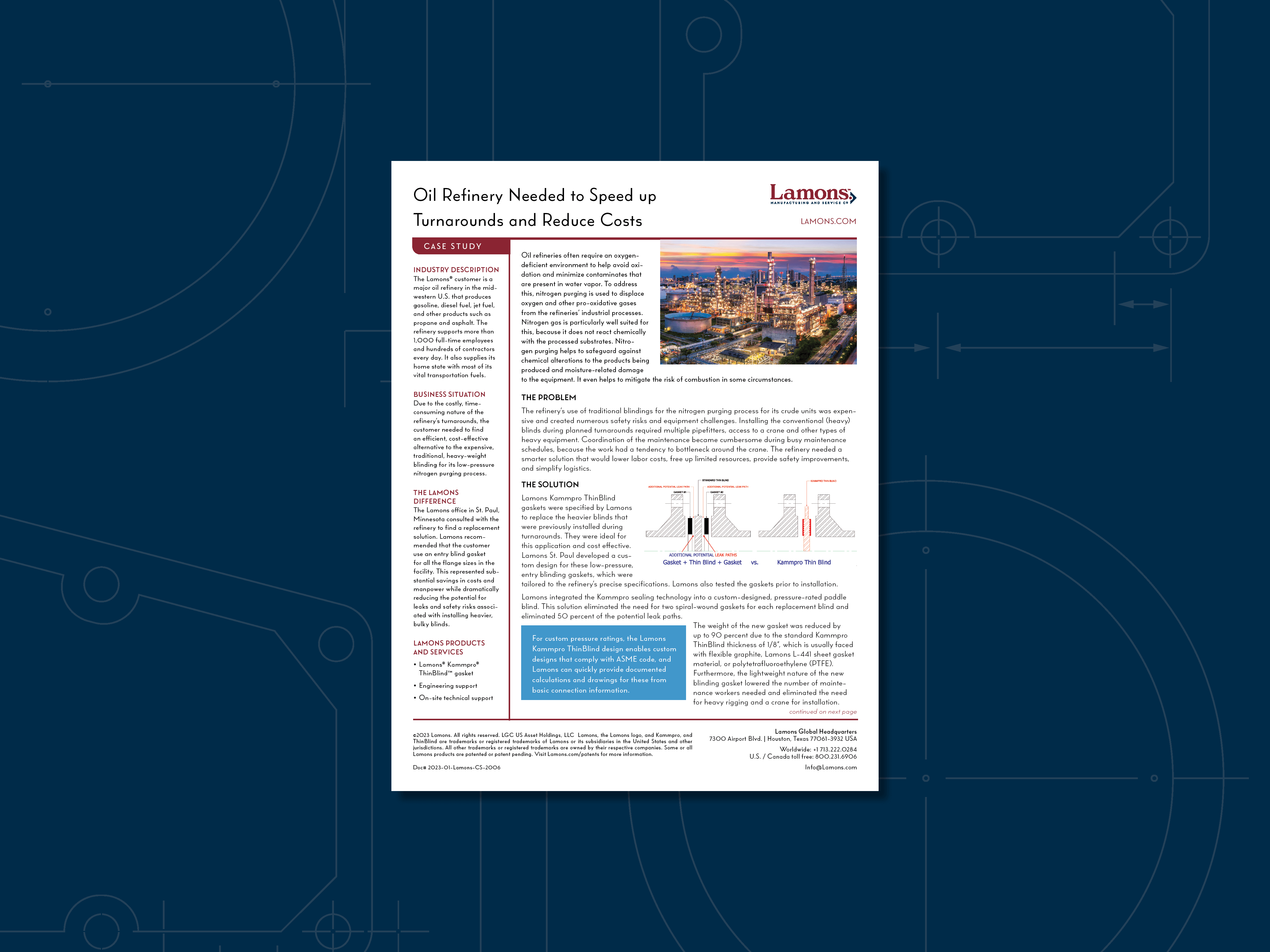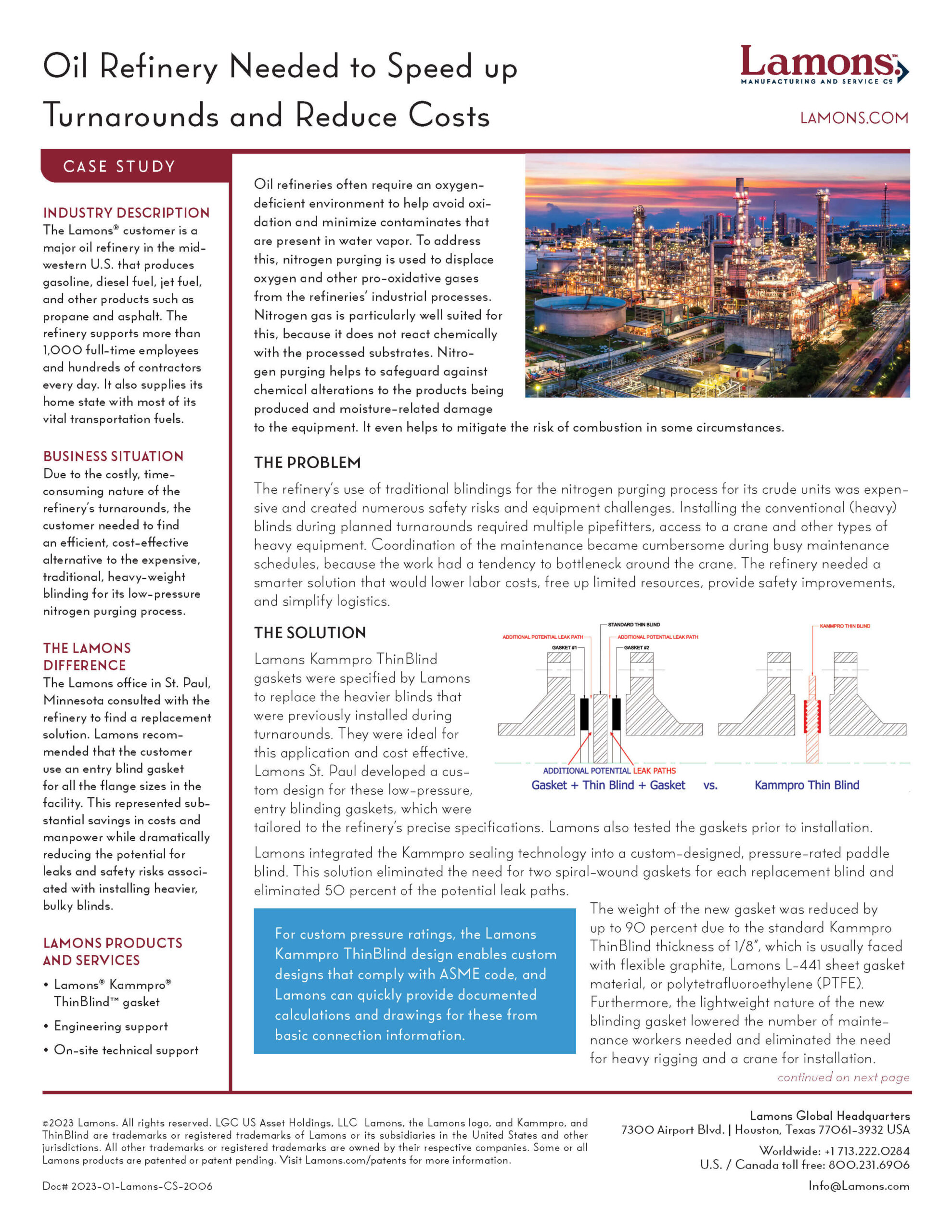
Oil refineries often require an oxygen-deficient environment to help avoid oxidation and minimize contaminates that are present in water vapor. To address this, nitrogen purging is used to displace oxygen and other pro-oxidative gases from the refineries’ industrial processes.
Nitrogen gas is particularly well suited for this, because it does not react chemically with the processed substrates. Nitrogen purging helps to safeguard against chemical alterations to the products being produced and moisture-related damage to the equipment. It even helps to mitigate the risk of combustion in some circumstances.
Industry Description
The Lamons® customer is a major oil refinery in the mid-western U.S. that produces gasoline, diesel fuel, jet fuel, and other products such as propane and asphalt. The refinery supports more than 1,000 full-time employees and hundreds of contractors every day. It also supplies its home state with most of its vital transportation fuels.
Business Situation
Due to the costly, time-consuming nature of the refinery’s turnarounds, the customer needed to find an efficient, cost-effective alternative to the expensive, traditional, heavy-weight blinding for its low-pressure nitrogen purging process.
The Lamons Difference
The Lamons office in St. Paul, Minnesota consulted with the refinery to find a replacement solution. Lamons recommended that the customer use an entry blind gasket
for all the flange sizes in the facility. This represented substantial savings in costs and manpower while dramatically reducing the potential for leaks and safety risks associated with installing heavier, bulky blinds.
Lamons Products and Services
- Lamons® Kammpro® ThinBlindTM gasket
- Engineering support
- On-site technical support
The Problem
The refinery’s use of traditional blindings for the nitrogen purging process for its crude units was expensive and created numerous safety risks and equipment challenges. Installing the conventional (heavy) blinds during planned turnarounds required multiple pipefitters, access to a crane and other types of heavy equipment. Coordination of the maintenance became cumbersome during busy maintenance schedules, because the work had a tendency to bottleneck around the crane. The refinery needed a smarter solution that would lower labor costs, free up limited resources, provide safety improvements, and simplify logistics.
The Solution
Lamons Kammpro ThinBlind gaskets were specified by Lamons to replace the heavier blinds that were previously installed during turnarounds. They were ideal for this application and cost effective. Lamons St. Paul developed a custom design for these low-pressure, entry blinding gaskets, which were tailored to the refinery’s precise specifications. Lamons also tested the gaskets prior to installation.
Lamons integrated the Kammpro sealing technology into a custom-designed, pressure-rated paddle blind. This solution eliminated the need for two spiral-wound gaskets for each replacement blind and eliminated 50 percent of the potential leak paths.
For custom pressure ratings, the Lamons Kammpro ThinBlind design enables custom designs that comply with ASME code, and Lamons can quickly provide documented calculations and drawings for these from basic connection information.
The weight of the new gasket was reduced by up to 90 percent due to the standard Kammpro
ThinBlind thickness of 1/8”, which is usually faced with flexible graphite, Lamons L-441 sheet gasket material, or polytetrafluoroethylene (PTFE). Furthermore, the lightweight nature of the new blinding gasket lowered the number of maintenance workers needed and eliminated the need for heavy rigging and a crane for installation.
The Results
Installation of the Lamons Kammpro ThinBlind gaskets took far less time and manpower than traditional blinds during turnarounds. This improved the time schedule for the contractors employed to work on multiple pieces of equipment.
The cost savings for the new materials to service the nitrogen purging process were substantial due to fewer, lighter-weight components being required. Additionally, the bolts needed for the new gaskets did not require changing bolt lengths like those used for the previous pancake or paddle blinds. This meant that the refinery could use standard-length bolts, which provided additional cost savings.
Another advantage for the customer was that Kammpro ThinBlind gaskets are reusable, requiring only a thorough cleaning, inspection, and re-facing, if needed. This provided
further savings for the refinery.
Lasting Business Benefits
Previously, overhead rigging was needed for replacing the larger, heavier blinds. The change to the lighter-weight blinds made conditions safer for the maintenance workers servicing the crude unit. The risk of personal injuries, such as back strains and pinched fingers, and unintended damage to production and maintenance equipment were substantially reduced. Additionally, the Lamons solution eliminated the need for heavy flange spreaders, which account for numerous pinch points during maintenance.
The refinery has since documented up to 75 percent cost savings for labor and up to 50 percent savings on material and equipment. Over the past four years, these savings have been extended across 10 scheduled outages, with each requiring considerably less downtime.
To discuss a challenge you are experiencing in your facility, contact [email protected]. For technical assistance, contact [email protected].










